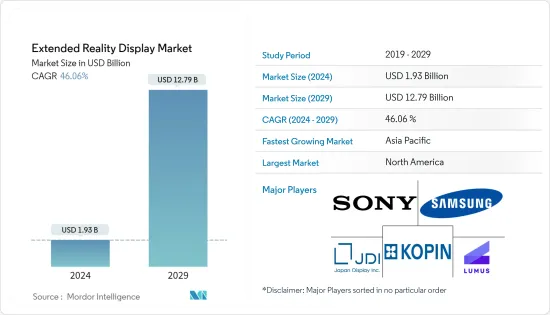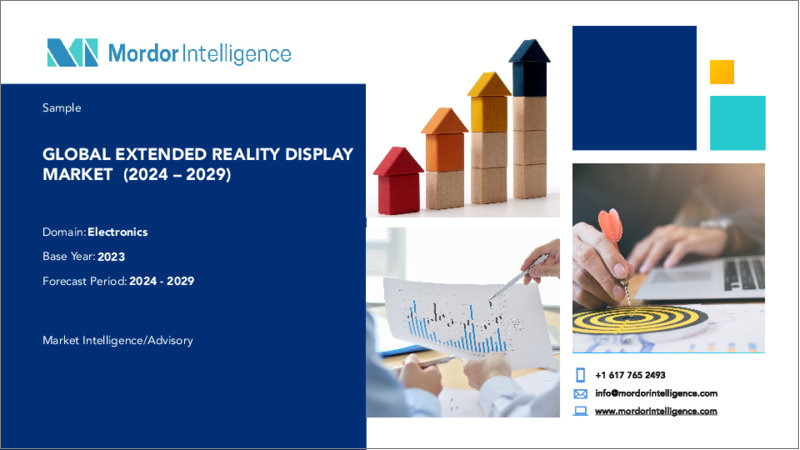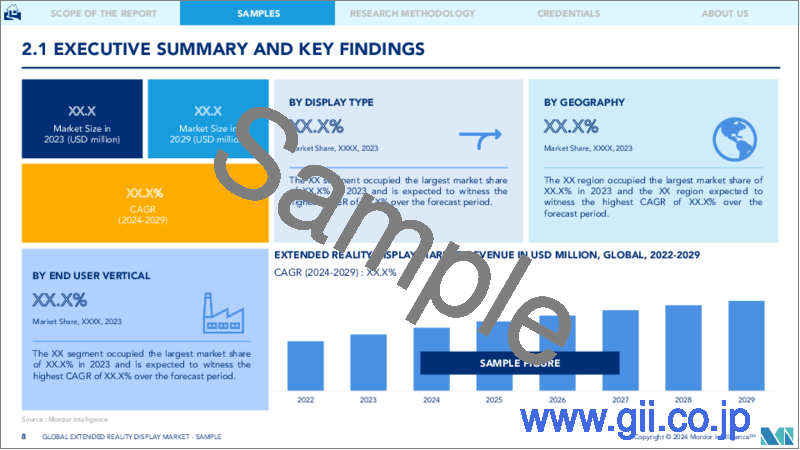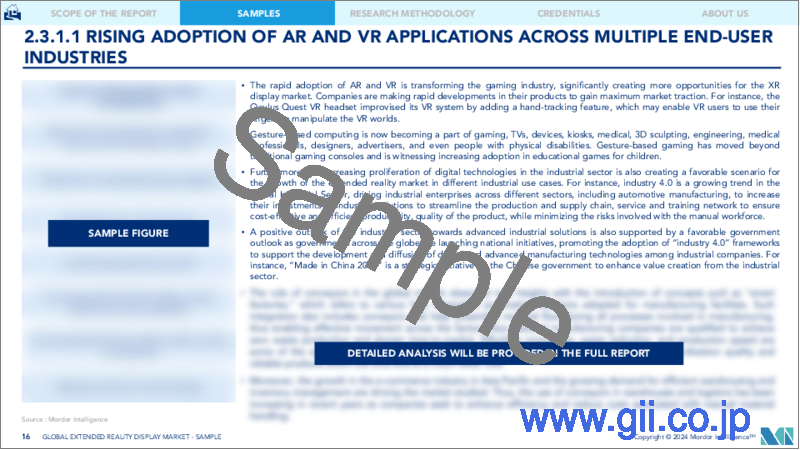|
|
市場調査レポート
商品コード
1435965
XR(エクステンデッドリアリティ)ディスプレイ:市場シェア分析、業界動向と統計、成長予測(2024~2029年)Extended Reality Display - Market Share Analysis, Industry Trends & Statistics, Growth Forecasts (2024 - 2029) |
||||||
|
● お客様のご希望に応じて、既存データの加工や未掲載情報(例:国別セグメント)の追加などの対応が可能です。 詳細はお問い合わせください。 |
|||||||
| XR(エクステンデッドリアリティ)ディスプレイ:市場シェア分析、業界動向と統計、成長予測(2024~2029年) |
|
出版日: 2024年02月15日
発行: Mordor Intelligence
ページ情報: 英文 142 Pages
納期: 2~3営業日
|
- 全表示
- 概要
- 目次
XRディスプレイの市場規模は、2024年に19億3,000万米ドルと推定され、2029年までに127億9,000万米ドルに達すると予測されており、予測期間(2024年から2029年)中に46.06%のCAGRで成長します。

パンデミックの発生は、小売、教育、ヘルスケアにおける拡張現実テクノロジーの開発を引き起こしました。ただし、他のエンドユーザー業界でXRテクノロジーの採用が加速したCOVID-19の影響にもかかわらず、ゲームおよびエンターテインメント業界ではXRテクノロジーの使用が常に主流でした。したがって、拡張現実市場におけるディスプレイの成長を促進します。
主なハイライト
- この調査で述べられている市場数値は、ゲーム、エンターテイメント、小売、ヘルスケア、教育、軍事と防衛、自動車と製造などのアプリケーション全体でベンダーが販売するディスプレイの価値を示しています。市場で使用されているディスプレイは、直視パネルまたはマイクロディスプレイパネルとして設計されています。 ARディスプレイパネルはシースルーとして設計されており、ユーザーは周囲の物理世界を完全に意識しながらデジタルデータを表示できます。
- COVID-19のパンデミックにより、市場で研究されているディスプレイの需要を促進するXRテクノロジーの採用が急増しました。たとえば、セフォラやウルタなどの美容小売業者は、顧客が美容製品を自分の肌で物理的にテストすることを禁止しなければなりません。美容小売業者は代わりに、消費者が製品をデジタルでテストして購入の意思決定を支援できるようにARに注目しています。
- したがって、パンデミックの影響で需要が短期的に増加するため、エンドユーザー環境での没入型テクノロジーの使用は今後数年間でさらに増加すると予想されます。
- さらに、複合現実の導入はさまざまな分野で勢いを増しており、目で見て情報を入手できることがさらなる利点となり、優位性をもたらします。 Microsoftは、アプリケーション分野を拡大するために製品の革新にますます注力しています。たとえば、2021年 3月、マイクロソフトは米国陸軍から、HoloLens 2をベースにしたヘッドセットを製造する契約を219億米ドル相当で獲得しました。このような開発は、この技術の採用にさらに影響を与え、市場で研究されているXRディスプレイの必要性を促進すると予想されます。
- XRテクノロジーが直面する最も困難な課題の1つは、より広範な視聴者、つまりより広範な市場を教育することに関係しています。現在のアプリケーション(スマートフォン、タブレット、ウェアラブル用)は1人のユーザーのみに制限されています。 XRをよりアクセスしやすくするには、マルチユーザーで均一かつ合理化されたエクスペリエンスを開発することが必須です。現在の市場シナリオでは、そのような製品の入手可能性は限られているため、市場の成長にとって大きな課題となっています。
- 今後数年間で、リアルタイムレンダリングとインタラクティブ AI、没入型体験の人気の高まり、5Gの普及により、劇場体験が変革され、XRディスプレイ市場の成長が促進されると予想されます。たとえば、エンドツーエンドの遅延(ユーザーの頭の動きとVRヘッドセットのディスプレイの変化の間の遅延)が非常に長い場合、ユーザーは乗り物酔いを経験する可能性があります。これを回避するには、VRシステムの遅延を20ミリ秒未満にする必要があり、5Gではこれを実現できます。したがって、5GはXR市場の需要をサポートすると予想されます。
XRディスプレイ市場動向
複数のエンドユーザー業界でARおよびVRアプリケーションの採用が増加
- ARとVRの急速な導入はゲーム業界を変革しており、XRディスプレイ市場により多くの機会を大幅に生み出しています。企業は市場での牽引力を最大限に高めるために自社製品の開発を急速に進めています。たとえば、Oculus Quest VRヘッドセットは、ハンドトラッキング機能を追加することでVRシステムを即興で改良し、VRユーザーが指を使ってVR世界を操作できるようにする可能性があります。
- ジェスチャーベースのコンピューティングは現在、ゲーム、テレビ、デバイス、キオスク、医療、3D彫刻、エンジニアリング、医療専門家、デザイナー、広告主、さらには身体障害のある人々の一部になりつつあります。ジェスチャーベースのゲームは従来のゲーム機を超えて、子供向けの教育用ゲームでの採用が増えています。たとえば、Magic Touch Mathは、カスタムジェスチャ描画を使用して数学を学習することに焦点を当てた最初のゲームです。したがって、ジェスチャベースの認識は、従来のゲームアプリケーション以外のアプリケーションでも使用できます。
- 2021年9月、アウディは路上での仮想現実エンターテインメントホロライドを発表しました。これにより、アウディの車内から仮想世界への旅行が可能になります。スタートアップのhololideは、カーライズをマルチモーダルな体験にすることに取り組んでいます。この新技術は、VRコンテンツと運転動作をリアルタイムで融合させ、アウディの後部座席の乗員がVRメガネを使用して車の運転動作にリアルタイムで適応することで、ゲーム、映画、プレゼンテーションに没頭し、仮想コンテンツを体験できるようにします。
- さらに、2021年 9月、イーストロンドン大学(UEL)は、EON Realityと提携してEON-XRセンターの立ち上げを発表しました。英国のEON-XRセンターでは、学生や講師がスマートフォン、Webサイト、VRヘッドセットなどのさまざまなデバイスを介してARおよびVRベースのトレーニングにアクセスできるため、調査対象市場の成長と需要が促進されます。したがって、このような開発により、市場で研究されているXRディスプレイの需要がさらに促進されると予想されます。
北米が大きなシェアを握ると予想される
- 米国政府が拡張現実技術を使用してイノベーションを促進し、繁栄を促進する直接的および間接的な方法を模索しているため、北米地域は大きな市場シェアを保持すると予想されています。
- たとえば、国務省の外務省は、特定の訓練に体験学習ツールとしてVRを導入しました。この地域では、地元の労働力を育成し、廃水を管理するために、いくつかのARおよびVRトレーニングプログラムが実施されています。
- この地域は、高度な技術への露出などの要因により、市場を独占しています。さらに、リソースが簡単に入手できるため、拡張現実デバイスに対する旺盛な需要が生まれています。いくつかの地域企業が、自社のAR/VRウェアラブルに革新的なディスプレイを導入しています。
- AppleからGoogleまで、米国のテクノロジー大手の多くはVRおよびAR機器の構築に多額の投資を行っています。ディスプレイはこのようなデバイスの重要な要素を形成するため、そのような投資は市場の成長を促進します。
- たとえば、2022年 6月、Facebookの親会社Metaは、メタバーステクノロジーの可能性を最大限に引き出すことを目指して、調査目的で4台の仮想現実(VR)プロトタイプディスプレイを発表しました。このモデルは、ヘッドセットを軽量化しながら、現実に近い視覚体験を提供し、解像度の低さ、視界の歪み、目の疲れなどの問題を解決することが期待されています。
- この地域には、AR/VRやその他の近眼画像製品用の高解像度 OLEDマイクロディスプレイの大手メーカーであるeMagin Corporationなど、多くの大手企業の本拠地もあります。同社は、2022年5月にカリフォルニア州サンノゼで開催されたディスプレイ市場に特化した業界最大規模のカンファレンスの1つであるDisplay Week 2022で、dPdダイレクトパターニングOLEDマイクロディスプレイテクノロジーを含む現行製品ラインの展示会を主催しました。
XRディスプレイ業界の概要
XRディスプレイ市場は主に複数の国内外の企業で構成されています。企業間の競争企業間の敵対関係は高く、予測期間中も変わらないと予想されます。市場の主要な企業には、ソニー株式会社、サムスン電子、コピン株式会社、ジャパンディスプレイ株式会社などが含まれます。市場における技術の進歩も企業に大きな競争上の優位性をもたらしており、市場では複数のパートナーシップも示されています。
- 2022年 6月-Kopinは、米国の元防衛請負業者向けに新しい車載ディスプレイ画像システムを開発する契約を獲得しました。新しいシステムは、Kopinの高輝度、高解像度、低電力強誘電性液晶オンシリコン(FLCOS)マイクロディスプレイとカスタム光学部品を非常に堅牢なカスタムハウジングに統合し、非常に過酷な環境での運用を可能にします。
- 2022年 6月 LGディスプレイは、Appleに第2世代複合現実(MR)デバイス用のディスプレイを供給する可能性のある基礎を計画しています。 LGはSunic Systemに蒸着装置を発注し、同社はマイクロOLEDパネルを生産できるようになります。
- 2022年 5月- サムスン電子は、最先端のディスプレイ技術であるThe Wallの3つの新しいモデルを備えた、Integrated Systems Europe(ISE)でマイクロLED技術を発表しました。 The Wallの次世代テクノロジーは、あらゆるビジネスを変革し、新たな機会を生み出すメリットをもたらします。
その他の特典
- エクセル形式の市場予測(ME)シート
- 3か月のアナリストサポート
目次
第1章 イントロダクション
- 調査の前提条件と市場の定義
- 調査範囲
第2章 調査手法
第3章 エグゼクティブサマリー
第4章 市場洞察
- 市場概要
- 業界の魅力- ポーターのファイブフォース分析
- 供給企業の交渉力
- 買い手の交渉力
- 新規参入業者の脅威
- 競争企業間の敵対関係の激しさ
- 代替品の脅威
- テクノロジーのスナップショット
- バーチャルリアリティ
- 拡張現実
- 複合現実
- COVID-19症による市場への影響の評価
第5章 市場力学
- 市場促進要因
- 複数のエンドユーザー業界でARおよびVRアプリケーションの採用が増加
- MicroLEDなどのマイクロディスプレイ全体の技術の大幅な進歩
- 市場抑制要因
- ディスプレイの製造に伴う複雑な製造プロセス
- 拡張現実ウェアラブルで利用できるコンテンツは限られています
第6章 市場セグメンテーション
- ディスプレイの種類別
- 液晶ディスプレイ(LCD)
- 有機発光ダイオード(OLED)
- その他の表示タイプ
- エンドユーザー業界別
- ゲームとエンターテイメント
- ヘルスケア
- 教育
- 軍事と防衛
- 自動車および製造業
- 小売り
- その他の用途
- 地域別
- 北米
- 欧州
- アジア太平洋地域
- 世界のその他の地域
第7章 競合情勢
- 企業プロファイル
- Sony Corporation
- Samsung Electronics Co., Ltd.
- Kopin Corporation
- Japan Display Inc.
- Plessey Company plc
- eMagin Corporation
- LG Display Co., Ltd.
- Lumus, Ltd.
- Seiko Epson Corporation
- BOE Technology Group Co., Ltd.
- Realfiction Holding AB
- SA Photonics, Inc.
第8章 投資分析
第9章 市場機会と将来の動向
The Extended Reality Display Market size is estimated at USD 1.93 billion in 2024, and is expected to reach USD 12.79 billion by 2029, growing at a CAGR of 46.06% during the forecast period (2024-2029).

The onset of the pandemic has triggered the development of extended reality technologies in retail, education, and healthcare. However, the use of XR Technologies has always been dominant in the gaming and entertainment industry despite the impact of COVID-19 that accelerated the adoption of XR technologies in other end-user industries. Thus, driving the growth for displays in the extended reality market.
Key Highlights
- The market numbers stated in the study indicate the value of displays sold by the vendors across applications such as gaming, entertainment, retail, healthcare, education, military and defense, automotive and manufacturing, and others. The displays used in the market are designed as either direct view panels or microdisplay panels. The AR display panels are designed as see-through and allow users to view the digital data while fully being aware of the physical world around them.
- The COVID-19 pandemic resulted in an upsurge in adopting XR technologies that drive the demand for displays studied in the market. For example, beauty retailers such as Sephora and Ulta have to forbid customers from physically testing the beauty products on their skin. Beauty retailers are instead turning to AR to help consumers digitally test products to assist in buying decisions.
- Therefore, the use of immersive technology in end-user settings is expected to increase further over the coming years due to the short-term growth in demand augmented by the effects of the pandemic.
- Moreover, Mixed reality adoption is gaining momentum in various sectors where information availability at the eyesight becomes an added advantage and gives an edge. Microsoft is increasingly focusing on innovating its offering to expand its application field. For instance, in March 2021, Microsoft won a contract from the US Army to produce headsets based on the HoloLens 2 worth USD 21.9 billion. Such developments are further expected to impact the adoption of the technology and drive the need for XR displays studied in the market.
- One of the most difficult challenges faced by the XR technology pertains to educating the wider audience - the broader market. The current applications (for smartphones, tablets, and wearables) are limited to a single user alone. For XR to be more accessible, developing multi-user, uniform, and streamlined experiences is a must. In the current market scenario, the availability of such products is limited, thus acting as a significant challenge to the market's growth.
- In the coming years, real-time rendering and interactive AI, the increasing popularity of immersive experiences, and the proliferation of 5G are expected to transform the theatrical experience and boost the growth of the XR display market. For instance, if the end-to-end latency (delay between the user's head movement and the change of the display in a VR headset) is very high, users can experience motion sickness. To avoid it, VR systems need less than 20ms latency, which a 5G can deliver. Thus, 5G is expected to support the demand for the XR market.
Extended Reality Display Market Trends
Rising Adoption of AR and VR Applications Across Multiple End-User Industries
- The rapid adoption of AR and VR is transforming the gaming industry, significantly creating more opportunities for the XR display market. Companies are making rapid developments in their products to gain maximum market traction. For instance, the Oculus Quest VR headset improvised its VR system by adding a hand tracking feature, which may enable VR users to use their fingers to manipulate the VR worlds.
- Gesture-based computing is now becoming a part of gaming, TVs, devices, kiosks, medical, 3D sculpting, engineering, medical professionals, designers, advertisers, and even people with physical disabilities. Gesture-based gaming has moved beyond traditional gaming consoles and is witnessing increasing adoption in educational games for children. For instance, Magic Touch Math is the first game that focuses on learning mathematics using custom gesture drawings. Thus, gesture-based recognition can also be used in applications apart from traditional gaming applications.
- In September 2021, Audi announced the virtual reality entertainment holoride on the road. This makes travel to virtual worlds from within an Audi possible. The startup holoride is working to make car rise a multi-modal experience. This new technology will merge VR content with driving movements in real-time to enable back seat passengers in Audi to dive into games, movies, and presentations and experience virtual content by adapting to the driving movements of the car in real-time using VR glasses.
- Further, in September 2021, the University of East London (UEL) announced the launch of an EON-XR Center in partnership with EON Reality. The EON-XR Center in the United Kingdom lets students and lecturers access AR and VR-based training through various devices, including smartphones, websites, and VR headsets.Thus, driving the growth and demand for the market studied. Thus, such developments are expected to further drive the demand for the XR displays studied in the market.
North America is Expected to Hold Significant Share
- The North American region is expected to hold a significant market share as the United States Government is finding both direct and indirect ways to use extended reality technology to facilitate innovation and promote prosperity.
- For instance, the Foreign Service Institute at the State Department has introduced VR as an experiential learning tool in specific training. Several AR and VR training programs have been implemented in the region to develop local workforces and manage wastewater.
- The region is dominating the market due to factors such as high technology exposure. Besides, the easy availability of resources has created a robust demand for extended reality devices. Several regional companies are deploying innovative displays into their AR/VR wearables.
- Many large American technology giants, from Apple to Google, are significantly investing in building VR and AR equipment. As the display forms a critical element in such devices, such investments will aid the market's growth.
- For instance, in June 2022, Facebook's parent company Meta unveiled four virtual reality (VR) prototype displays for research purposes as the company seeks to achieve the full potential of metaverse technology. The models are expected to deliver visual experiences that closely resemble reality and solve problems such as poor resolution, distorted views, and eye fatigue while making headsets lighter.
- The region is also home to many major players, such as eMagin Corporation, a major manufacturer of high-resolution OLED microdisplays for AR/VR and other near-eye imaging products. The company hosted an exhibit of its current product line, including its dPd Direct Patterning OLED Microdisplay Technology, at Display Week 2022, one of the industry's largest conferences devoted to the display market, in San Jose, California, in May 2022.
Extended Reality Display Industry Overview
The Extended Reality Display Market primarily comprises multiple domestic and international players. The competitive rivalry is expected to be high and remain the same during the forecast period among the players. Significant players in the market include Sony Corporation, Samsung Electronics Co., Ltd., Kopin Corporation, Japan Display, Inc., etc. Technological advancements in the market are also bringing considerable competitive advantage to the companies, and the market is also witnessing multiple partnerships.
- June 2022 - Kopin was awarded a contract to develop a new in-vehicle display imaging system for a US prime defense contractor. The new system would integrate Kopin's high-brightness, high-resolution, low-power ferroelectric liquid crystal on silicon (FLCOS) microdisplay and custom optic into a heavily ruggedized custom housing to enable operational use in extremely harsh environments.
- June 2022 - LG Display is planning the groundwork to potentially supply Apple with displays for its second-generation mixed reality (MR) device. LG will order deposition equipment from Sunic System, allowing the company to produce micro OLED panels.
- May 2022 - Samsung Electronics launched Micro LED technology at Integrated Systems Europe (ISE) with three new models of its state-of-the-art display technology, The Wall. The next-generation technology of The Wall would deliver benefits for transforming any business and unlocking new opportunities.
Additional Benefits:
- The market estimate (ME) sheet in Excel format
- 3 months of analyst support
TABLE OF CONTENTS
1 INTRODUCTION
- 1.1 Study Assumptions and Market Definition
- 1.2 Scope of the Study
2 RESEARCH METHODOLOGY
3 EXECUTIVE SUMMARY
4 MARKET INSIGHTS
- 4.1 Market Overview
- 4.2 Industry Attractiveness - Porter's Five Forces Analysis
- 4.2.1 Bargaining Power of Suppliers
- 4.2.2 Bargaining Power of Buyers
- 4.2.3 Threat of New Entrants
- 4.2.4 Intensity of Competitive Rivalry
- 4.2.5 Threat of Substitutes
- 4.3 Technology Snapshot
- 4.3.1 Virtual Reality
- 4.3.2 Augmented Reality
- 4.3.3 Mixed Reality
- 4.4 Assessment on the impact due to COVID-19 on the market
5 MARKET DYNAMICS
- 5.1 Market Drivers
- 5.1.1 Rising Adoption of AR and VR Applications Across Multiple End-user Industries
- 5.1.2 Significant Technological Advancement Across Micros Displays Such as MicroLEDs
- 5.2 Market Restraints
- 5.2.1 Complex Manufacturing Process Involved for the Production of Displays
- 5.2.2 Limited Content Available for the Extended Reality Wearables
6 MARKET SEGMENTATION
- 6.1 By Display Type
- 6.1.1 Liquid Crystal Displays (LCD)
- 6.1.2 Organic Light-Emitting Diode (OLED)
- 6.1.3 Other Display Type
- 6.2 By End-User Industry
- 6.2.1 Gaming and Entertainment
- 6.2.2 Healthcare
- 6.2.3 Education
- 6.2.4 Military and Defense
- 6.2.5 Automotive and Manufacturing
- 6.2.6 Retail
- 6.2.7 Other Applications
- 6.3 By Geography
- 6.3.1 North America
- 6.3.2 Europe
- 6.3.3 Asia Pacific
- 6.3.4 Rest of the World
7 COMPETITIVE LANDSCAPE
- 7.1 Company Profiles
- 7.1.1 Sony Corporation
- 7.1.2 Samsung Electronics Co., Ltd.
- 7.1.3 Kopin Corporation
- 7.1.4 Japan Display Inc.
- 7.1.5 Plessey Company plc
- 7.1.6 eMagin Corporation
- 7.1.7 LG Display Co., Ltd.
- 7.1.8 Lumus, Ltd.
- 7.1.9 Seiko Epson Corporation
- 7.1.10 BOE Technology Group Co., Ltd.
- 7.1.11 Realfiction Holding AB
- 7.1.12 SA Photonics, Inc.




